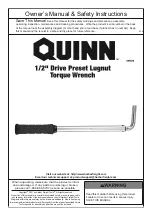
HIT-HY 100 Adhesive Anchoring System
HIT-HY 100 Adhesive Anchoring System
5
Hilti, Inc. (USA) 1-800-879-8000 I
www.us.hilti.com
I en español 1-800-879-5000 I Hilti (Canada) Corp. 1-800-363-4458 I
www.hilti.ca
I HIT-HY 100 Technical Supplement 01/14
2.0 Technical Data
2.1 Testing and Product
Evaluation
Hilti HIT-HY 100 has been tested in accordance with ICC
Evaluation Services (ICC-ES) Acceptance Criteria for Post-
Installed Adhesive Anchors in Concrete Elements (AC308).
Hilti has had Hilti HIT-HY 100 evaluated according to AC308
and has received ESR-3574 from ICC-ES.
2.2 Adhesive Anchor Design
Codes
2.2.1 United States
For post-installed and cast-in anchor systems, design
calculations are performed according to ACI 318 Appendix D.
This has been a requirement of the International Building Code
(IBC) since 2003. ACI 318-11 Appendix D introduced for the
first time specific equations for the design of adhesive anchor
systems using threaded rod or rebar. Prior to this only post-
installed expansion and undercut anchors and cast-in headed
studs were recognized.
Prior to the publication of ACI 318-11, designers of post-
installed adhesive anchor systems used ACI 318-08 Appendix
D and Section 3.3 of AC308 which provides amendments
to Appendix D. These amendments provide the relevant
equations to design a post-installed adhesive anchor.
At the time of this publication, ESR-3574 for Hilti HIT-HY 100
includes the design provisions for ACI 318-08 and AC308
Section 3.3.
2.2.2 Canada
CSA A23.3-04 Annex D provides the required limit states
design equations for post-installed mechanical anchors, and
for cast-in headed studs. At the time of this publication, Annex
D, which is a non-mandatory part of the Canadian code, does
not address adhesive anchor design or test criteria.
Since Annex D does not provide guidance for the design of
adhesive anchor systems, it is the position of Hilti that the
design provisions of ACI 318-11 Appendix D can be used for
the design of Hilti HIT-HY 100 in Canada. The foundations
of a proper adhesive anchor design are now well established
through ACI 318-11 and a proper chemical anchor design in
the United States would be also relevant in Canada. It will be
shown in later sections how to relate the results from technical
data in this supplement to the Canadian design standard.
2.3 Design of Hilti HIT-HY 100
Adhesive Anchor System
2.3.1 Using technical data in
ESR-3574
Technical data for the system components of Hilti HIT-HY 100
can be found in ICC-ES ESR-3574. This includes:
• Hilti HIT-HY 100 adhesive.
• Standard threaded rods and rebar.
• Hilti HIS-(R)N internally threaded inserts.
A designer can use the data in ESR-3574 to calculate the
capacity of the Hilti HIT-HY 100 system in the following manner:
• For standard threaded rods, rebar and the Hilti HIS-(R)N
internally threaded inserts, a design using either ACI 318-11
Appendix D or ACI 318-08 Appendix D and AC308 Section
3.3 amendments to ACI 318 would be appropriate.
The tables from ESR-3574 are not included in this supplement,
but can be found by downloading ESR-3574 from
www.us.hilti.com or on the ICC-ES website at www.icc-es.org,
or by contacting your local Hilti representative.
2.3.2 Using the New Hilti
Simplified Design Tables
In lieu of providing a copy of ESR-3574 design tables in this
supplement, Hilti is providing a new, simple approach for
designing an anchor according to the current codes described
in Section 2.2. Refer to Section 2.4 for a description of these
new innovative tables.
2.4 Hilti Simplified Design Tables
The Hilti Simplified Design Tables is not a new “method” of
designing an anchor that is different than the provisions of ACI
318 Appendix D or CSA A23.3 Annex D. Rather, it is a series
of pre-calculated tables and reduction factors meant to help
the designer create a quick calculation of the capacity of the
Hilti anchor system, and still be compliant with the codes and
criteria of ACI and CSA.
The Hilti Simplified Design Tables are formatted similar to the
Allowable Stress Design (ASD) tables and reduction factors
which was a standard of practice for design of post-installed
anchors.
The Hilti Simplified Design Tables combine the simplicity of
performing a calculation according to the ASD method with the
code-required testing, evaluation criteria and technical data in
ACI Appendix D and CSA Annex D.






































